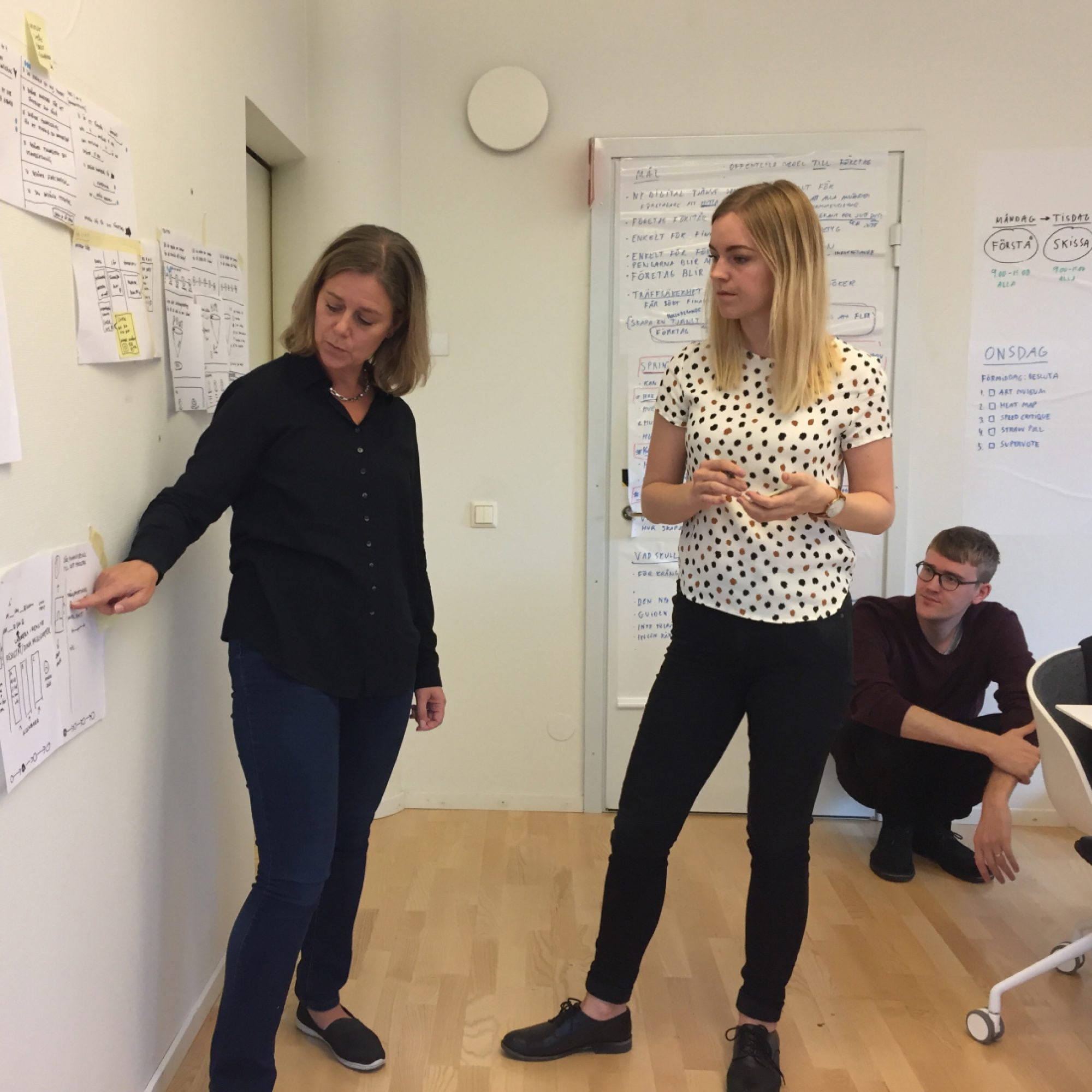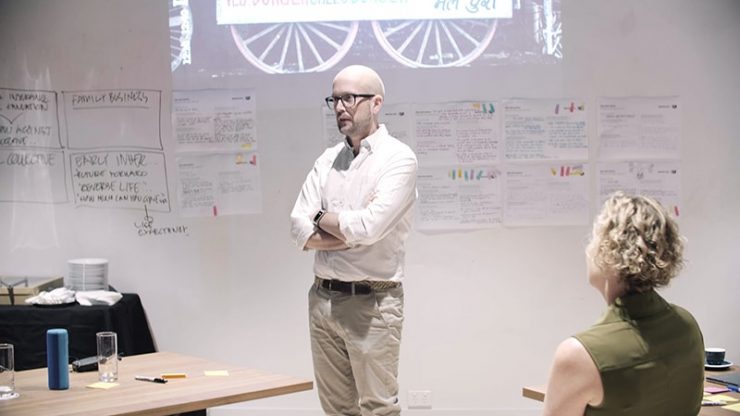The Innovation FAQ
We have compiled answers to some of the most frequently asked questions we get on innovation. Do you have any questions unanswered? Please let us know!
Mail us as podcast@hellofuture.com.

How do you define innovation?
First of all, the meaning of innovation needs to be defined and agreed upon in each organisation, making sure it is implemented strategically and that everybody in the organisation is aligned. Otherwise, you’ll quickly find that any misalignment will result in a lack of focus and poor results.
Innovation can generally be defined as turning an idea into a solution that adds value from a customer’s or user’s perspective.
If the focus is strategic and the organisation is aligned, innovation can generally be defined as turning an idea into a solution that adds value from a customer’s or user’s perspective. Or even simpler put: value from ideas.
Why does innovation matter?
Innovation is crucial for economic progress and social well-being. It is a powerful tool to address societal issues, from resource scarcity and climate warming, through to poverty and health issues. Consequently, innovation has become a significant part of regional, national and international economic policies.
Innovation is also important in the corporate world. From mature and well-established industry giants, to young, up and coming startups and SMEs, every company needs to be working with innovation. Innovation is key to current and long-term competitive advantage.
Study after study show that companies who prioritise innovation survive longer and provide higher returns to shareholders. Why? Because innovation helps companies grow, helps them stay relevant to their users, and differentiates them from competitors and other similar organisations.
How do we find the time to innovate?
This is in practice one of the biggest obstacles to innovation. Innovation work requires substantial blocks of time in which to focus and concentrate. Unfortunately, innovation is often regarded as supplementary to an employee’s job: something that they have to do when all the “important” work is done.
The organization’s leadership should demonstrate that innovation is a priority, by establishing a clear and actionable vision for the future
But there are ways that the C-suite can combat this. First the organisation’s leadership need to demonstrate that innovation is a priority, by establishing a vision for the future and by sharing stories about ideas that people have had, how teams developed those ideas and the results. Then they should create a plan and schedule for the innovation project and let it be managed as a project.
Finally, the C-suite needs to understand that innovation is more likely to result from structured group workshops than from solitary independent work, and reward creative thinking and innovative action.
How do we get the C-suite to support innovation?
An organisation’s leadership has a profound influence on its ability to innovate successfully. If you’re leading innovation, it’s vital to get the C-suite’s onboard since their stewardship will be the difference between smooth sailing and rough waters.
If you have an idea and want to get your leaderships support, make an effort to frame it in the context of their challenges and problems, such as what is keeping them awake at night, and who is pressuring them and for what result? Often the first step is the hardest, so make it easy for them to support you by providing a clear action step with an explanation of the benefits they’ll get from taking action.
Why is innovation so difficult?
In a 2021 survey, 86 percent of executives said that innovation in their organisation is a top three priority, yet fewer than 10 percent were satisfied with their organisations’ innovation performance. This underlines just how hard innovation can be. The list of reasons most innovation initiatives fail is long, but a fundamental reason is the lack of a clear vision and a well-defined and aligned innovation strategy.
How do we get started with innovation?
The hardest part of innovation is actually getting started. Your first priority should be to work out what you want your future to look like. Where do you want to go, and how do you plan to get there?
Most organizations envision the future as just a version of yesterday with perhaps some minor tweaks, but an innovation vision needs to be much more ambitious
Having an idea of the end destination is an essential first step. This is best accomplished by engaging in vision work with the leadership to paint a picture of the future. Most organisations unfortunately envision the future as just a version of yesterday with perhaps some minor tweaks, but an innovation vision needs to be much more ambitious. To really start envisioning an organisation’s future takes hard work and focus.
What is an innovation strategy and how do you create one?
An innovation strategy is based on the objectives of the organisation’s agreed-upon vision. This vision should be the base of an aligned portfolio of ideas that are then actively managed. If you do this correctly you will hopefully be able to maximize the positive impact to the customers and users of the organisation and the organisation itself.
Each organisation needs to determine its own unique challenges, envision an attractive future and create order in its portfolio of projects and initiatives that will take it forward to meet those goals.
What is innovation management?
Innovation management involves the process of managing an organization’s innovation strategy, from the development of ideas through to the final stage of successful implementation. Innovation management encompasses the ideas, decisions, activities and practices of devising and executing an innovation strategy.
Who in the organization should manage innovation?
The C-suite team needs to be committed and responsible for the direction, the culture and the building of the project group or partners for the actual work. That can come only from the leadership team. But leaders beneath the C-suite then need to develop the knowledge, the methods, and the rhythm and activities for getting the job done.
Where should we innovate first?
To establish your initial innovation focal point, consider the company or organization’s pain points — touchpoints where customers, employees, or users have complained or offered negative feedback. These pain points can uncover reasons a company or organization is losing business to competitors, not connecting with users and customers, or being unable to communicate effectively with its employees.
Finding methods to address these issues can have a domino effect that drives innovation in other areas, too. For example, tackling complaints about difficulties reaching customer support could involve new technologies that not only connect customers to the company on demand, but also create internal communication channels for employees to collaborate and interact on.
How do we encourage innovation in an organization?
Your organization must acknowledge and welcome the possibility of failure
The C-suite must develop an organizational innovation strategy, part of which should be to incentivize staff to think about innovation. An integral part of such a process is to recognize that innovation always carries the risk of failure.
For every example of transformational innovation, there are hundreds of ideas that just don’t work out. Your organization must acknowledge and welcome the possibility of failure, and encourage speculative initiatives to help employees approach innovation in a more inventive and open-minded fashion.
The leadership also needs to commit to open communication and transparency. Your staff need to know the C-suite is open about the importance for innovation, and the potential benefits for the company. The employees also need clear, consistent information about the organization’s innovation goals, and how they could personally benefit if they get things right.

How do we minimize risk in innovation projects?
The history of innovation highlights one uncomfortable truth – the vast majority of ideas will fail. The failure of ideas will never be completely eradicated but there are methods of minimizing the risk of investing too much time and too many resources into ill-suited ideas. Design thinking and service design are two such complementary methods. Both design thinking and service design are well suited to handle the early, complex and hazy phases of the innovation process.
Design thinking is essentially a solution-based approach, used by non-designers, to solve problems. This is most useful when tackling complex issues that are indistinct or ambiguous, because it seeks to understand the human needs involved.
Service design is the practical application of design thinking by designers into a service that is useful, usable and efficient for customers and end-users. The purpose of both approaches is to test ideas with actual users as soon as possible. By doing this you quickly get feedback on the validity of an idea and whether or not it actually solves a problem, and you also gather valuable information on how the solution can be developed to best meet developing needs. Read more about service design here.
How do we measure progress on new ideas?
It is crucial to focus on what is important to measure – not what is easy to measure. Many organizations measure what is easy to measure rather than what is important. Innovation is best managed with a long term view, and best measured by targeted goals.
It is important to realize that these goals are not static, and should be routinely reviewed and updated. The next most important thing is to link these measures and metrics with reward and recognition systems — both are equally important.
Which KPIs do we use to track innovation?
Without metrics, investments in innovation are difficult to evaluate because innovation and ideas need comparable KPIs to control parameters. Without metrics substantiated decision-making is difficult.
How do we keep people engaged in the innovation process?
Maintaining employees’ interest in the organisation’s innovation program is essential, if you are to harvest and benefit from their ideas and input. Creating a customer-focused (or end-user focused) culture is a good first step.

Diagnosing and evaluating customer pain points can provide organisations with a strong market advantage. According to research, the most successful innovations spring from a desire to help people overcome day-to-day struggles. There are many ways to create a more customer-focused culture, including frequently sharing with employees customer insights, and expressly linking customer needs to your organization’s own culture and vision.
How do we innovate with positive social impact?
Forward-thinking organisations are keen to develop business solutions that boost growth and improve social outcomes, superseding the traditional trade-off between financial gain and social good. There are many strategies that an organization can pursue for innovations that deliver measurable social impact, such as engaging in networked problem solving with other organizations to pinpoint and test possible solutions to scale, and using external services to accelerate the development of the solution.
However, a key consideration is whether the initiative connects with the culture and values of the organization and its stakeholders? And does the team running the social innovation process have a practical feel for the organization’s strengths, possible blind spots, and areas in which external assistance might be needed?
What is ‘The Innovator’s Dilemma’?
The Innovator’s Dilemma is a much-praised 1997 book by Clayton Christensen. The dilemma of the title is that although large organizations have a degree of motivation to innovate, they also have a strong disincentive from doing so because new products will undermine their existing ones, and perhaps drive away customers for the old products.
There are two kinds of technologies: disruptive and sustaining, and if an organization’s resources, processes and values don’t match the market, the organization is likely doomed.
How can we make innovation easier?
- Set clear goals that are aligned with your strategy.
- Empower teams below the C-suite to make decisions.
- Listen to the customer/end-user.
- Enable employees to approach innovation in an inventive and open-minded fashion.
- Innovation is best managed with a long term view, and best measured by targeted goals.
- Use design thinking methodology to more quickly test ideas and save time.
- Successful innovation is 1% inspiration and 99% perspiration. Hard, consistent work is the fundamental building block for productive innovation.